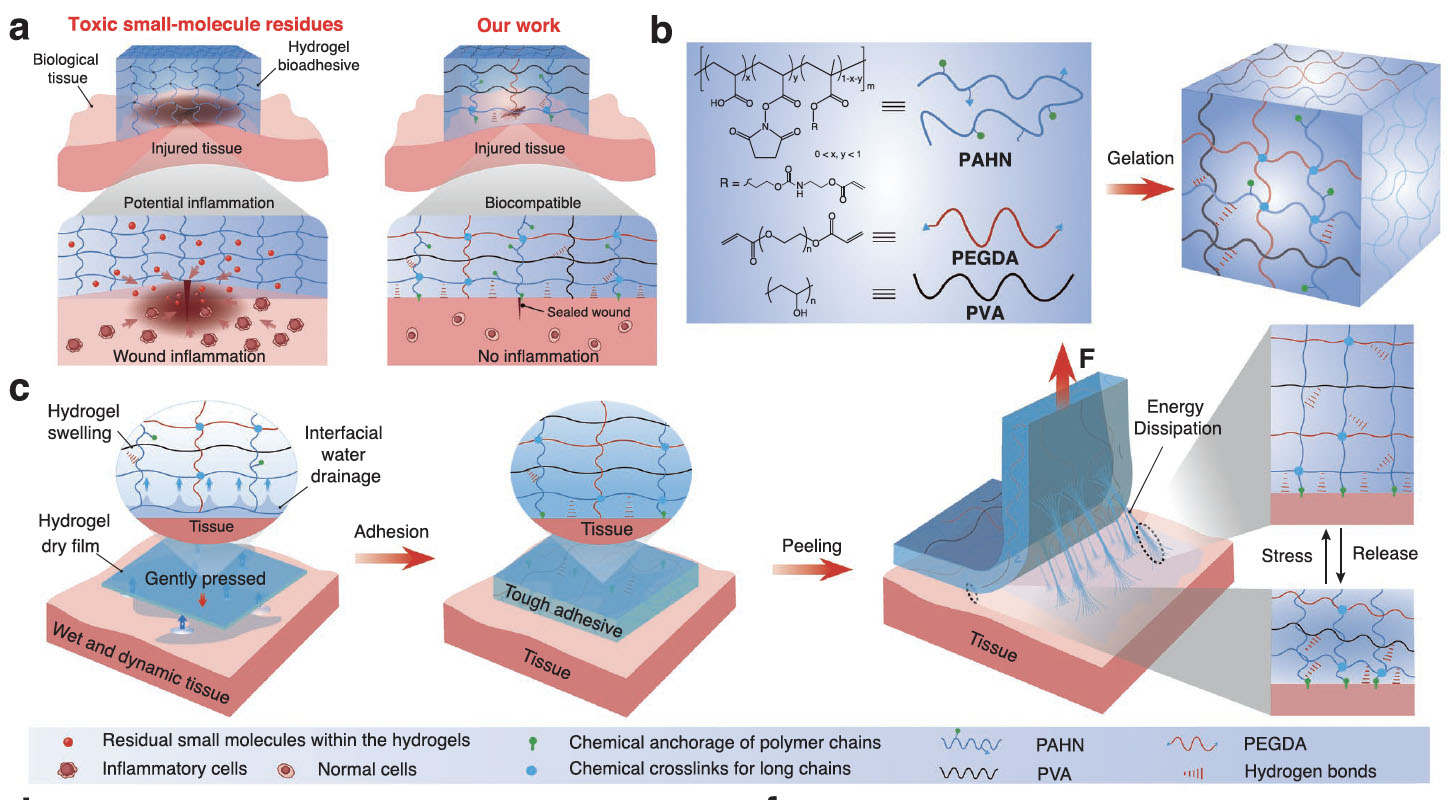| Apr 27, 2022 |
Synthetic hydrogels for wound sealing and biointerfaces
(Nanowerk News) Hydrogels are fascinating natural or synthetic polymer materials that exhibit very versatile chemistries and physical or biological properties. They are 3D networks of either physically or chemically crosslinked polymers that resemble organic tissues and that can hold large amounts of water within their interlocked molecular network (read more in our Nanowerk primer on hydrogels).
|
|
Hydrogels have emerged as one of the most promising material candidates to seamlessly construct the tissue–tissue or tissue–electronics interfaces, in light of their biological, mechanical, chemical, and physical similarity to tissues.
|
|
For instance, extremely conductive graphene hydrogels have been developed for medical applications and DNA-based nanocomposite hydrogels as a potent injectable drug delivery platform.
|
|
However, existing hydrogel-based adhesives have been challenged by their poor control over adhesion activation, inferior adhesion performance, as well as potential immunological side-effects.
|
|
Addressing these issues, researchers have reported in Advanced Functional Materials ("Tough Hydrogel Bioadhesives for Sutureless Wound
Sealing, Hemostasis and Biointerfaces") a synthetic hydrogel bioadhesive from a variety of polymer precursors, featuring instant formation of tough biointerface, allowing for wet and robust adhesion with highly dynamic biological tissues.
|
 |
| Design and fabrication of inflammation-free and tough hydrogel bioadhesives. a) Schematic illustration of potential inflammatory responses caused by toxic small-molecule residues within previously-reported hydrogel bioadhesives. Our proposed hydrogel bioadhesives are prepared from a mixture of polymer precursors, without involving any small-molecule reactants, thus no inflammation response occurs. b) The polymer precursor mixture solution is composed of functional PAHN polymer bearing NHS and acrylate moieties, PEGDA and biopolymer (i.e., PVA, gelatin, SA, or CTS). The gelation process is activated by UV irradiation. c) The dry-crosslinking mechanism of the hydrogel adhesives involves the instant drainage of interfacial water by hydration and swelling of the hydrogel dry film, temporary crosslinking through hydrogen bonding, and subsequent covalent crosslinking and chain entanglement. Energy dissipation within the hydrogels and interfacial chemical anchorage synergistically yield a biointerface with high toughness. (Reprinted with permission by Wiley-VCH Verlag) (click on image to enlarge)
|
|
The researchers' fabrication process successfully gets rid of monomers, thereby avoiding any immunological side-effects associated with small-molecule residues.
|
|
The instant and tough adhesion of this novel hydrogel originates from the biomimetic interfacial water drainage mechanism, followed by synergistic contribution from both hydrogen bonds and chemical cross-linking.
|
|
The team also demonstrates that their hydrogel bioadhesives could be used for in vivo hemostasis and wound sealing. They even could be used as biointerfacing materials to anchor bioelectronics onto a beating heart, allowing for wireless monitoring of heart beats.
|

 By
Michael
Berger
– Michael is author of three books by the Royal Society of Chemistry:
Nano-Society: Pushing the Boundaries of Technology,
Nanotechnology: The Future is Tiny, and
Nanoengineering: The Skills and Tools Making Technology Invisible
Copyright ©
Nanowerk LLC
By
Michael
Berger
– Michael is author of three books by the Royal Society of Chemistry:
Nano-Society: Pushing the Boundaries of Technology,
Nanotechnology: The Future is Tiny, and
Nanoengineering: The Skills and Tools Making Technology Invisible
Copyright ©
Nanowerk LLC
